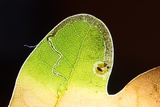Stigmella ruficapitella (Haworth, 1828) Species
Last modified: Dec. 18, 2024, 5:38 p.m.
Status insufficiently known due to the difficulty of different mines on the food plant, but it is assumed to be a very rare species.
Details
- Classification
- Family: Nepticulidae > Genus: Stigmella > Species: Stigmella ruficapitella
- Vernacular names
- Variabele eikenmineermot (NL), Red-headed Pigmy (EN)
- First mention in Belgium
- De Fré Ch. 1858. Catalogue des Microlépidoptères de la Belgique. — Annales de la Société entomologique belge 2: 45–162. On page 152 (as N.[epticula] Ruficapitella. Haw.). view page
- Status
-
Native
Distribution
Egg
The egg is laid on the upper side close to the edge of the leaf.
Caterpillar
The larva is yellow-colored and can be found in June-July and September-October.
Mine
The mine starts with a relatively short corridor that widens moderately. Usually, the initial corridor runs along the leaf edge. In the initial corridor, the frass lies in a narrow central line, later it lies more in a wide band of arcs or lies granularly in a central line. The sides of the mine always remain free of frass.
Cocoon/pupa
The cocoon is reddish-brown.
Flight periods
The adults fly in two generations per year from late May to September.
Observed on
- Host plant (genera):
- Quercus
The larva mines different species of Quercus like Q. petraea, Q. robur and Q. pubescens.




